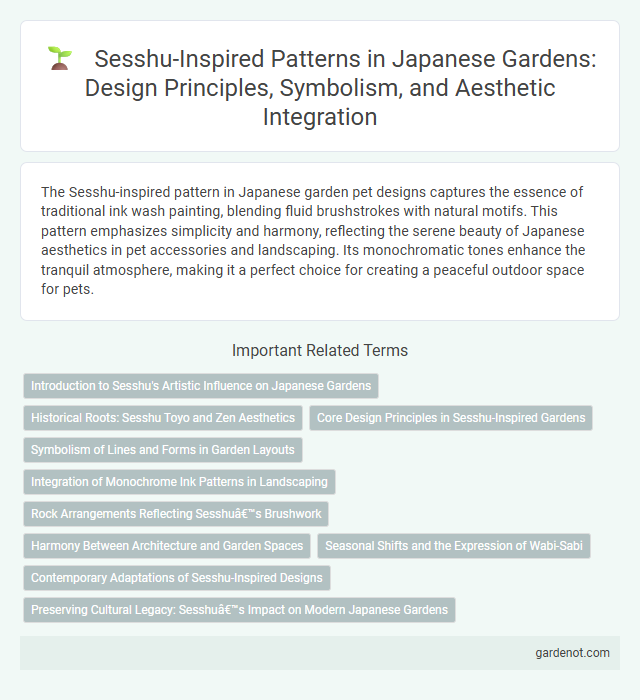The Sesshu-inspired pattern in Japanese garden pet designs captures the essence of traditional ink wash painting, blending fluid brushstrokes with natural motifs. This pattern emphasizes simplicity and harmony, reflecting the serene beauty of Japanese aesthetics in pet accessories and landscaping. Its monochromatic tones enhance the tranquil atmosphere, making it a perfect choice for creating a peaceful outdoor space for pets.
Introduction to Sesshu's Artistic Influence on Japanese Gardens
Sesshu Toyo's artistic influence on Japanese gardens is profound, reflecting his mastery in ink painting and Zen aesthetics. His bold brushwork and minimalist composition inspired garden designs that emphasize asymmetry, natural simplicity, and contemplative spaces. The Sesshu-inspired pattern integrates stone arrangements and plant placements to evoke the rhythmic flow and spiritual depth characteristic of his artwork.
Historical Roots: Sesshu Toyo and Zen Aesthetics
Sesshu Toyo, a renowned 15th-century Japanese ink painter, profoundly influenced Japanese garden design through his integration of Zen aesthetics emphasizing simplicity, asymmetry, and natural beauty. His artistic patterns, characterized by bold brushstrokes and minimalist compositions, reflect the principles of Zen Buddhism that promote meditation and harmony with nature. These historical roots manifest in gardens that evoke tranquility and contemplation, embodying Sesshu's legacy within Japanese cultural heritage.
Core Design Principles in Sesshu-Inspired Gardens
Sesshu-inspired gardens emphasize the core design principles of asymmetry, simplicity, and the use of negative space to evoke natural landscapes on a miniature scale. These gardens integrate bold brushstroke-like rock arrangements and carefully pruned plants to reflect Sesshu Toyo's ink painting aesthetics, creating a harmonious balance between solid forms and voids. The interplay of texture, shadow, and empty space guides the viewer's eye, embodying the Zen philosophy of wabi-sabi and fostering contemplative tranquility.
Symbolism of Lines and Forms in Garden Layouts
Sesshu-inspired Japanese garden layouts emphasize the symbolism of lines and forms, where meticulously raked gravel patterns represent flowing water and natural landscapes. The interplay of curved and straight lines guides viewers' perspectives, creating a meditative flow that embodies harmony and balance. Stones and plants are arranged to evoke mountains and rivers, reflecting Sesshu Toyo's ink painting techniques in three-dimensional space.
Integration of Monochrome Ink Patterns in Landscaping
Sesshu-inspired patterns in Japanese garden landscaping emphasize the integration of monochrome ink aesthetics, mirroring the bold brushstrokes and subtle gradients of traditional sumi-e painting. These designs incorporate carefully arranged rocks, gravel, and moss to replicate the fluidity and texture found in Sesshu Toyo's monochromatic art, creating a harmonious balance between natural elements and artistic expression. This approach enhances the garden's visual depth while maintaining a minimalist and meditative atmosphere central to Zen garden principles.
Rock Arrangements Reflecting Sesshu’s Brushwork
Rock arrangements in Japanese gardens inspired by Sesshu Toyo emulate his dynamic brushwork through precisely placed stones that mimic the fluidity and bold strokes of ink painting. These compositions create a visual rhythm, capturing the essence of Sesshu's monochrome landscapes by balancing simplicity with expressive detail. By integrating asymmetry and natural textures, the gardens evoke the artist's mastery of capturing movement and emotion in a static medium.
Harmony Between Architecture and Garden Spaces
The Sesshu-inspired pattern emphasizes seamless integration between architecture and garden spaces, reflecting traditional Japanese aesthetics that prioritize balance and flow. Natural elements such as stones, water, and plants are carefully arranged to complement wooden structures, creating a tranquil environment that blurs indoor and outdoor boundaries. This design philosophy fosters harmony by aligning spatial composition with Zen principles, enhancing both visual appeal and spiritual experience.
Seasonal Shifts and the Expression of Wabi-Sabi
Sesshu Toyo's brushstroke techniques in Japanese gardens evoke the fleeting beauty of seasonal shifts through minimalist designs that embody the wabi-sabi aesthetic, emphasizing impermanence and subtle imperfection. The pattern incorporates asymmetry and natural textures, highlighting the transient qualities of moss, stone, and weathered wood that change with each season. This approach fosters a serene environment where the quiet passage of time is celebrated as an essential element of nature's beauty.
Contemporary Adaptations of Sesshu-Inspired Designs
Contemporary adaptations of Sesshu-inspired patterns in Japanese garden design emphasize bold ink brushstroke motifs that replicate the master's dynamic sumi-e style, integrating minimalist rock arrangements and asymmetrical layouts for modern aesthetics. Designers incorporate abstracted natural elements such as pine trees and flowing water, using gravel and stone to evoke the textural contrasts characteristic of Sesshu Toyo's landscapes. This fusion blends traditional Japanese artistic principles with innovative landscaping techniques, creating serene spaces that honor historical art forms while appealing to contemporary tastes.
Preserving Cultural Legacy: Sesshu’s Impact on Modern Japanese Gardens
Sesshu Toyo's ink paintings profoundly influence the design principles of modern Japanese gardens, emphasizing asymmetry, natural simplicity, and dynamic spatial flow. His Sesshu-inspired patterns integrate traditional brushstroke aesthetics to create landscapes that balance minimalism with expressive detail, preserving the cultural legacy of Muromachi period artistry. These gardens serve as living museums, encapsulating Sesshu's philosophical approach to nature and artistic expression within contemporary horticultural practice.
Sesshū-inspired pattern Infographic

 gardenot.com
gardenot.com